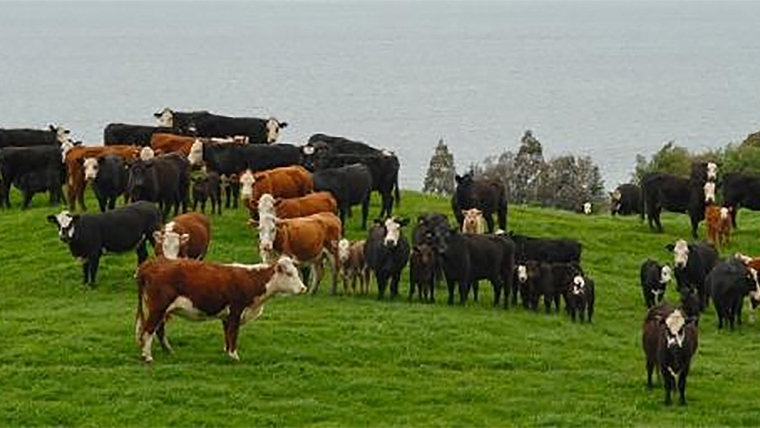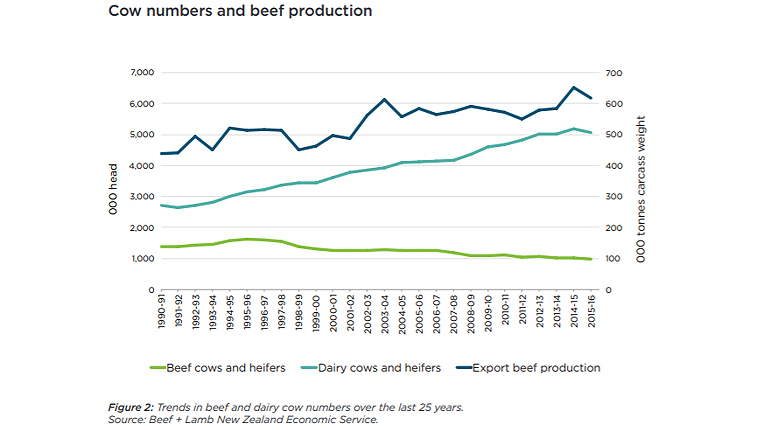
Coming from a sheep and beef background I have always had difficulty in understanding the huge gulf that exists between the physiology of beef cow and the dairy cow.
The beef cow can turn the rankest feed into high quality milk and grow a valuable calf and get in calf again herself with the minimum of fuss. It is this ability that has made the beef cow such an integral and valuable component of hill country farms.
Unfortunately, with the worst country (and not always the worst) going into forestry or being retired. and subdivision. and droughts also increasing. for different reasons the beef cow numbers have been steadily declining. In the 45 years from 1973 to 2018 numbers nearly halved from 1.9 million cows to 0.97 million cows.
And economics and efficiencies mean that the beef cow is not likely to make a resurgence.

What got me thinking about the demise of the beef cow was some news and research coming out of CRV Ambreed discussing how the stronger the estrous a cow exhibits when getting in calf, the more likely she is of retaining the calf through gestation. Nothing shows the difference between the beef and dairy cow more than the issues around getting in and staying in calf. Anything over a dry rate of 6% in beef cow herds used to be considered a failure with often only 1-2% dries being common.
Whereas from what I’ve seen of the dairy industry anything under 12% dry is a success and rates of 25% not uncommon.
Research from animal scientists and changing practices by farmers have tried for decades to get on top of the dry cow problem and while some small steps have been made it still appears to be a major handbrake on the industries efficiency. I certainly don’t have any advice except to perhaps to make the observation that as with the issue with bobby calves; that is, what to do with them, the industry has long since lost sight of the fact they are dealing with a biological system that involves animals, and success shouldn’t necessarily be measured by the amount of milk in the vat.
A glimmer of good news, also from CRV Ambreed and LIC was that the amount of sexed semen being sold has also increased. It appears that the majority of the sexed semen is to breed for more heifers calves from the better quality cows, but bull semen also appears to have increased, presumably to increase the rate of male calves from the cows that are not suitable for keeping replacements from.
Both of these approaches ideally should help reduce the numbers of bobby calves going to the works.
Just what the true rate of the bobby calf kill would be (in normal conditions) is a little difficult to make too many assumptions about due to the influence of M.Bovis the previous couple of years. That is, rearing calves looked a risky occupation under M.Bovis for a while leading to more calves being killed, although that happily appears to no longer be the issue it was.
Now with the price collapse under the pandemic conditions there is another influence to distort the numbers. But, with dairy farmers provided with some tools that allow more calves to dodge the bobby truck it will no doubt kept animal welfare critics at bay and hopefully make farmers feel a bit more satisfied they are working in a more sustainable industry.
Climate update
Now that COVID-19 has almost become a normal part of life’s landscape - it’s been 9 months since the virus broke out of China - the climate is starting to feature more and more on the international news. Record fires, floods and storms are becoming common place.
New Zealand mostly enjoyed a reasonably mild winter, which was just as well given the challenges with drought and closed saleyards etc of the autumn. Unfortunately, at least for a large part of the South Island after a relatively dry winter, the NIWA outlook for the Spring (September - November) is normal to below normal rainfall (along with thee west coast of the North Island). Already as of the 4th of September I saw my first irrigator at work (no, it wasn’t cow effluent) and to prove a point, we have had the hose on the garden.
In my limited experience in the South Island it seems unusual to have both the west and east coasts both coming under the same weather projections. There is normally rain coming from one direction. The top half of the North Island is predicted to be normal or above with only the East Coast looking to be normal.
Not surprisingly the whole country is predicted to have temperatures well above average. If the pandemic hasn’t been enough to deal with its impact upon prices and stock movements, we can only hope the climate doesn’t again throw another wild card into the mix. No one promised farming would be easy, only interesting.
Saleyard Prime Steer
Select chart tabs
6 Comments
If cows are in trouble then breeding hinds might be on the way to extinction. Obviously beef cows have a very important role to play in pasture quality , but the only way fowards must be increasing fecundity . That's the way sheep have survived.
Sheep might have survived but the national flock has declined even faster and further than beef. It's the usual thing though with NZ.. everyone chases the latest "get rich quick" scheme. I remember when people were ripping out Kiwifruit blocks to sell as lifestyle blocks, now people are charging into forestry and avocado's, and the lifestyle blocks are going into housing developments. People rush in to "Tourism" ventures with little more than a boat and a charter licence. It's the same old same old.. Boom and Bust. Those that do well stick to their knitting, freehold themselves and ride it out. Those that don't tend to drown in the rainstorm while chasing the rainbow.
Aye, a good recipe soon gets overcooked. Orange roughy was another example.
There is another problem with running breeding cows, that is the quality of a lot of our hill country. As a hill farmer I rely on our cows to keep thatch at bay for the sheep, which are the prime source of income. But unfortunately the damage caused, particularly in winter, of top soils is just speeding up the degrading process of the hills. When you look at the prime cattle areas of the world which are generally easy undulating land.and often drier you come to the realisation that the majority of our farm land is unsuitable for large numbers of cattle.
Big problem with running a beef cow is the volume of water they need over the summer months. I would love to have more but for this problem. They do a magnificent job from May eating old grass and exposing sub clover for maximum growth allowing excellent weight gain for early lamb. I generally manage to avoid any soil damage from them. I have more soil damage from R2 finishing cattle as you try to push them along on better quality country.
Yeah 100% thats what I reckon also. So how do we deal with this long term problem?
PS Heavy cattle is the problem on our light soils. By that I mean carrying pregnant cows without supplement feed. And I have to add,if you feed them it comes of the bottom line as in profit. Which is rather slim.

We welcome your comments below. If you are not already registered, please register to comment.
Remember we welcome robust, respectful and insightful debate. We don't welcome abusive or defamatory comments and will de-register those repeatedly making such comments. Our current comment policy is here.